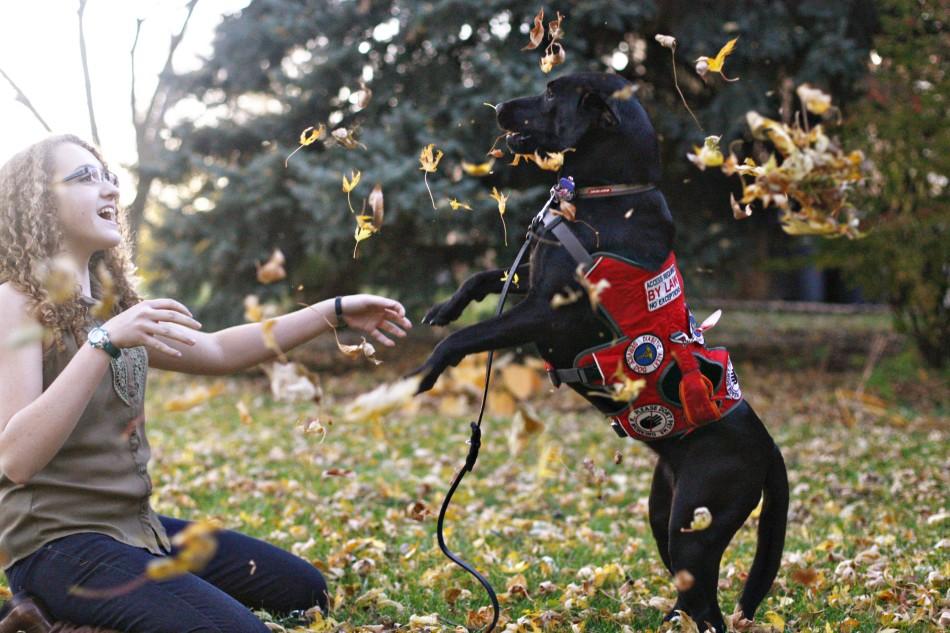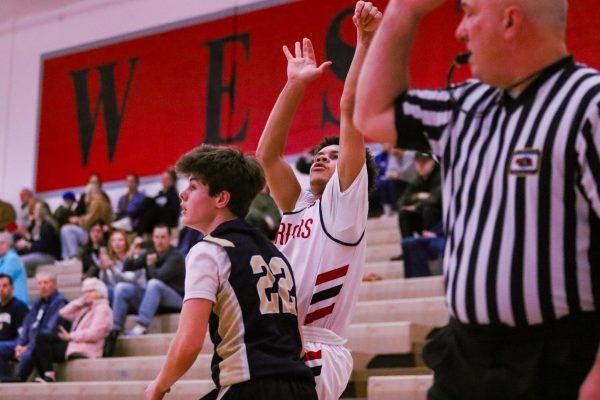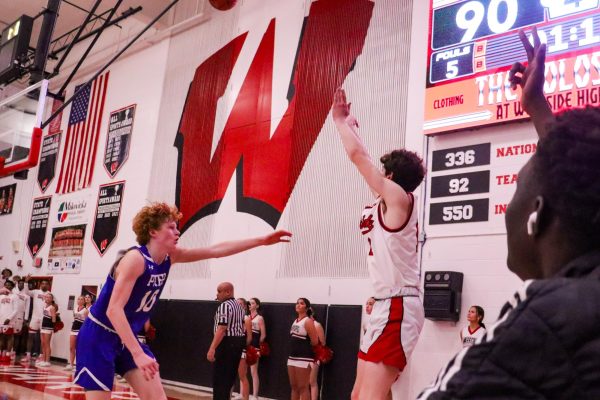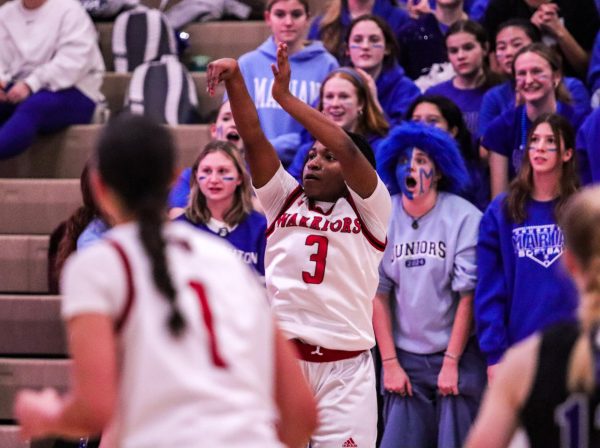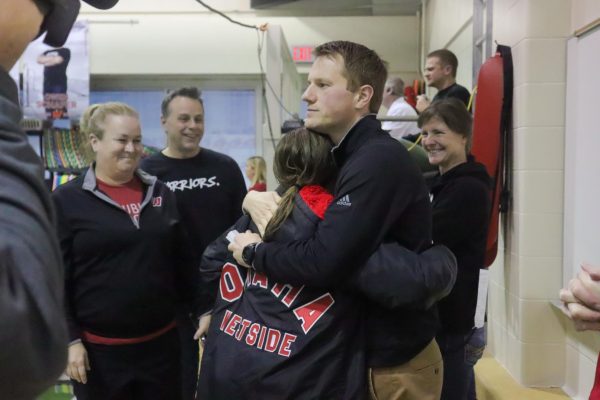Sophomore Trains her own Service Dog
Maxi is the first to get up in the morning.
Her jobs range from getting sophomore Amy Conaway out of bed to making sure someone set out the dog food at 6 a.m. sharp.
Maxi is a 60-pound, 2-foot tall, amber-eyed black Lab who runs like a bullet and enjoys long walks in the park. Her day is packed with family time, training, outings and naps, all with the goal of shaping her into a successful Diabetic Alert Dog.
Five years ago, Conaway was diagnosed with Type 1 diabetes. Three years later, Conaway decided to train her own service dog. She adopted Maxi from a group who bred dogs specifically for their ability to sense changes in blood sugar.
“How we started training was [Maxi] got involved with testing my blood sugar,” Conaway said. “Like when I was testing, she would come over and watch. And then if I was out of range — if I was low or high — I would breath in her face. We would reward that. That smell we tried to associate with good things.”
The first time Maxi noticed a high or low on her own, she ran around the house and started growling at Conaway.
“She knew something was wrong and wanted her reward,” Conaway said. “Any behavior that was different, we rewarded that because that was her noticing the smell.”
The next step in training was learning how to alert. When Conaway’s blood sugar was out of range, Maxi needed some way to let Conaway know. For the Conaways, a Bringsel was the right fit.
A Bringsel is a stick of fabric that Maxi can grab and bring to Amy anytime Maxi senses something is amiss. They are located all over the house, on doorknobs and on the fridge, and then on Maxi’s leash when they go out.
“The biggest reason we wanted her was to alert at night because I sleep through low blood sugars which is potentially dangerous, especially when I go to college,” Conaway said.
One day, Conaway left school with a migraine. She tested her blood sugar, but was in a healthy range so she decided to sleep it off. It was late afternoon when Maxi alerted Conaway and her mother. After testing, they found that Conaway was in the 40s; the normal range is 70 to 100.
Thankfully, Conaway was treated before anything dangerous happened, like a seizure or a coma.
“To us, that was one of those moments where you’re like, ‘All this hard work is worth it. She really is here for a reason,” Conaway said. “My mom probably wouldn’t have checked my blood sugar for another two hours.”
Maxi’s typical Labrador characteristics like a good work ethic, family personality and smart sense of smell contribute to her success as a service dog. Conaway, however, thinks that it’s not all in Maxi’s breed, but more in her personality and her relationship with Conaway.
“[Maxi] motivates me to keep in control of [my diabetes] because if I don’t, it makes it harder on her,” Conaway said. “It’s kind of like facing it as a team, instead of feeling like I have to do it all by myself.”
The team came about because of a simple idea from Conaway’s neighbor, senior Ruby Hickman.
“I have raised and trained a therapy dog, and when I was doing research for that I came across diabetic alert dogs,” Hickman said. “The concept that a dog can sense the changes in a person’s blood sugar is astounding, and I did more research to ensure that it was legitimate. I brought the idea [up with Conaway], and it turned out to be a great fit.”
Conaway was in a Spanish language immersion camp when she found out about her successful adoption of Maxi. Her parents sent her a photo album and behind pictures of her family were two pictures of a little black Lab in a patch of flowers.
Handwritten next to it was: “This is your dog, but she needs a name.”
“I just looked at the picture for the longest time and then ran to the bathroom and cried,” Conaway said. “Then I started showing everyone in camp so I could get their opinions on names.”
Maxi, eventually named after the horse in Disney’s Tangled, Maximus, has been at Conaway’s side for two years. With the help of the trainers from Warren Retrievers and other trainers the family met later on, Maxi has gradually learned what it takes to be a service dog.
The Lab passed the Canine Good Citizen test at the Nebraska Humane Society with flying colors. She could walk by a pile of toys without stopping to sniff and do a “meet and greet”. When Amy stops to talk to someone with another dog, Maxi could wait patiently without a reaction.
From there, Conaway and Maxi took regular outings to places including Scheels, Hy-Vee and even on a plane to work on their skills in public.
“[Taking her to school] is our end goal,” Conaway said. “I want to take her to college, but it’s also up to the school. Right now, I don’t think she’s ready, and I also don’t think I’m ready.”
Conaway’s biggest fear is passing period. In stores and during outings, Maxi has been stepped on by accident because people didn’t notice there was a dog there.
“You know how crazy the Landing is,” Conaway said. “I just want her to be safe.”
Maxi does her best to be careful and do her job. She makes Conaway and her mother proud with every successful outing and alert. She’s waiting outside Conaway’s bedroom door every morning and in her crate for Conaway after school. Her bathroom breaks and mealtimes are arranged around Conaway’s activities for the day, but Maxi is flexible.
“There are worse things in the world than diabetes, but it’s still a pain in the butt,” said Conaway. “I think [Maxi] is the one positive thing that I get every day out of it. It’s the fact that I get this awesome dog.”
This is an article from issue two of the Lance about Westside junior Amy Conaway. Conaway was selected for the Better Business Bureau’s (BBB) Service Excellence Award Tuesday, April 1. Conaway will be recognized at Rotary’s Annual Honor Roll Luncheon Wednesday, May 7 at 11:30 a.m. at the CenturyLink Center. The BBB Foundation will also be honoring her at its Integrity Awards Event Tuesday, Oct. 7. BBB will be awarding her with $200 to give to a charity of her choice.
Your donation will support the student journalists of Omaha Westside High School. Your contribution will allow us to purchase equipment and cover our annual website hosting costs.


